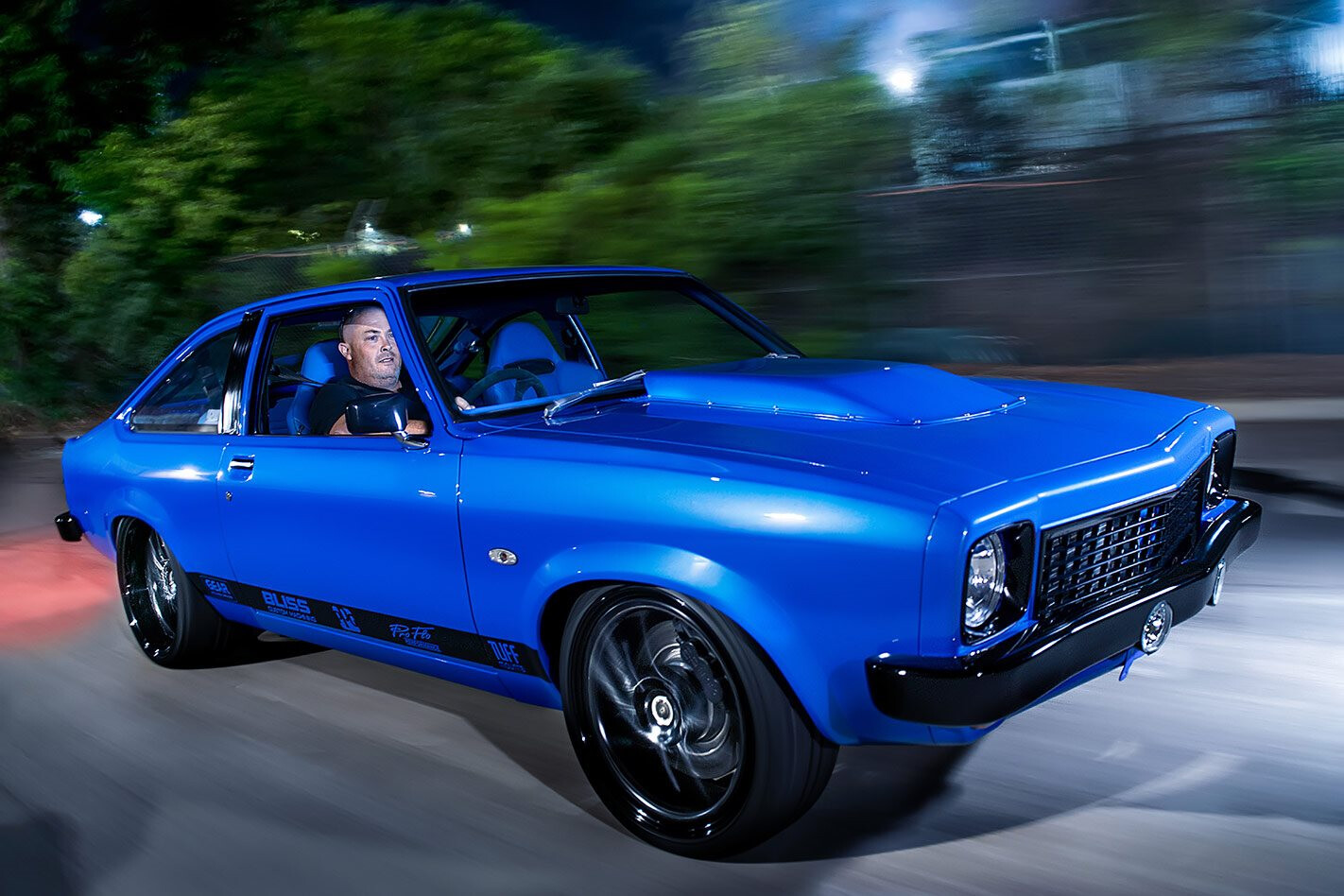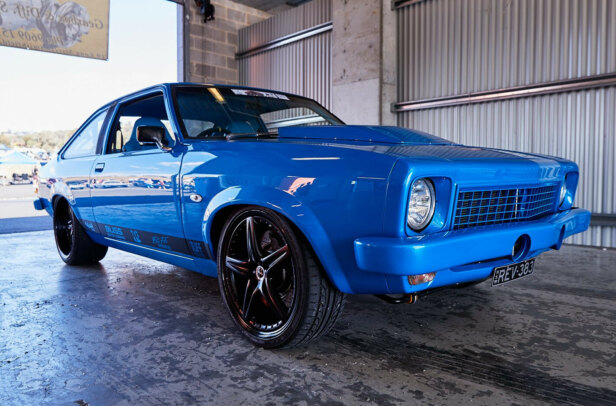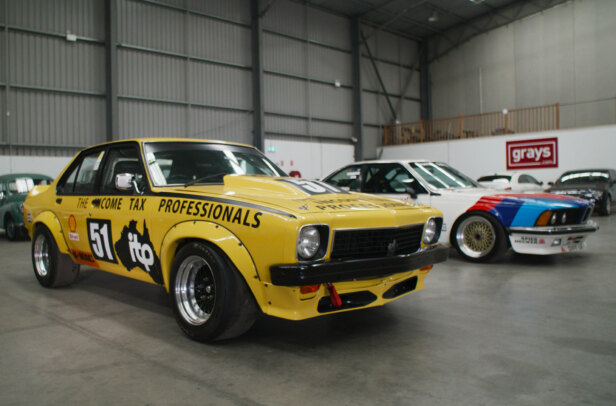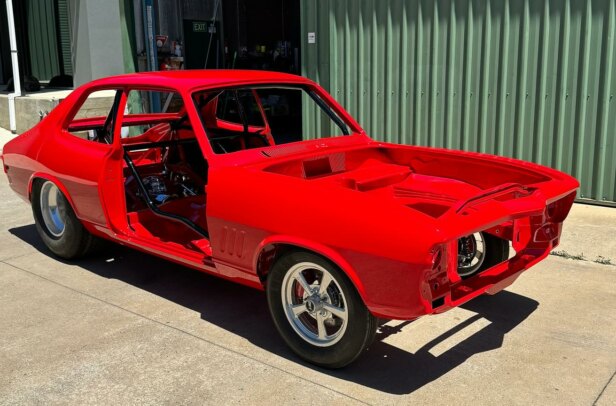This article on John Spinks’s Torana was originally published in the April 2015 of Street Machine magazine
THEY sure don’t make ’em like they used to. It might be cliché, but it stands true as far as cars are concerned. Today’s cars are mere consumables to be used and abused then discarded for the next thing. More plastic than metal, they’re not conducive to being named, nurtured, and passed from one generation to the next. Classic cars, by comparison, are living, breathing entities that have personalities all their own, with idiosyncrasies and character traits that allow a person to develop a real rapport with their ride.
Stance comes courtesy of a set of custom-made Sydney Suspension rear coil-overs, teamed with Lovells coils and Koni adjustable shocks up front. Brakes are huge AP Racing jobbies with six-piston front calipers and four-piston calipers on the rear, so the hatch steers and stops every bit as well as she goes
Sydney’s John Spinks, for example, has enjoyed a long and colourful relationship with his clinically clean and brutally tough LX Torana hatch that stretches back 22 years – more than half his life. They’ve had more than their fair share of ups and downs, but right now, everything’s ticking along just nicely.
Satin-black highlights give the car a menacing presence. The body is largely standard, except for Mustang-style driving lights, which were integrated into the modified front bar
He first locked eyes with the LX – then a stock six-cylinder hatch – aged 17, when his boss bought it to flip and make a quick buck. John snapped up its 173ci six and Celica five-speed for his HR, and the roller was sold to an acquaintance of his old man.
ROH Modenas measure up at 19x10in on the rear, wearing 275-wide tyres that fill out the standard, unflared guards a treat
“He had it tucked away in the rafters, and I wanted it so bad,” John says. “I was constantly hassling him to sell it to me, and eventually Dad talked him into parting with it.”
As luck would have it, the car was pre-pollution, so John wasted little time in stuffing a 327ci Chev junkyard motor, Turbo 400 and 12-bolt rear end into it. Being an apprentice painter, he also gave it a lick of green paint, and proceeded to drive the wheels off it. A minor freshen-up saw the Chev stretched out to 350 cubes and the engine bay resprayed, before it was eventually yanked once more to be replaced with a big-block.
“I couldn’t find an engineer who’d certify it, and when a twin-throttlebody VL Group A engine came up, I decided to go in a different direction,” John explains. “I had it rebuilt with forgies, a solid cam and good heads, and fitted it up with a T56 six-speed manual. I wanted it to steer, stop and handle too, so I fitted trick suspension, wide tyres on 19-inch ROH wheels, and big AP Racing brakes. It had to be really neat, but I wanted to be able to take it out and do track days, too.”
That was well over 10 years ago, so it’s fair to say that the hatch was a pro tourer long before the scene had found its feet here in Australia. At the time the car retained its mint-green paint job from the initial build and wore the plates MINTI. The look has evolved dramatically in the years since, but the car still retains that race-ready DNA.
How the aesthetic overhaul came about is a tale of woe. John was cruising to Oran Park for a track day when a number of injectors sprang loose from their seals, spraying the hot engine with fuel. The subsequent fire made a real mess of the engine bay, and seeing as the Group A mill had to come out anyway to repair the damage, John spoke to Paul Sant at ProFlo about liberating a few more ponies. A tough 383ci combo was agreed upon, and took the LX to the next level.
Hours upon hours of sheet metal work by Lowe Fabrications, heaps of trick billet parts and a supreme eye for detail have delivered a unique, elite-level engine bay, which houses a fire-breathing 383ci Holden. The Bliss Custom Machining eight-throttle manifold is an absolute work of art
“It was a pretty neat car that went well and won a lot of trophies,” John says. “So I drove it down to Summernats to have a crack at the Elite Hall.
“Unfortunately, a good mate of mine crashed into it on the roundabout outside EPIC and did $16,000 worth of damage to the front end. Needless to say I didn’t make the Elite Hall!”
The damage from the smash was repaired by Detroit Customs, before the hatch was rolled into Lowe Fabrications’ headquarters, where Chubby and John performed a comprehensive engine bay overhaul that now forms the centrepiece of this beautiful street-driven show car.
Every square inch of sheet metal under the hood was customised, and each element – from the flat firewall, sculpted inner guards and boxed chassis rails, to the radiator support and nosecone – flows together seamlessly. The firewall is devoid of the standard master cylinder and booster arrangement, with a Wilwood under-dash pedal box instead tasked with fluid transfer duties.
The bay is a veritable Aladdin’s cave of Aussie-made CNC billet bling from Bliss Custom Machining, including the bonnet hinges, timing cover, alternator bracket and rocker covers. But the exquisitely constructed Bliss eight-throttlebody cross-ram EFI manifold is the real star of the show.
The cockpit is motorsport-inspired and show quality, with digital instruments, custom-trimmed Recaro seats and billet accessories, including the custom shifter for the T56 six-speed cog-swapper. No stereos allowed!
The engine itself is the same ProFlo-built 383ci stroker combo, based on the four-bolt Group A block. It sports a COME Racing crank and rods, SRP forged slugs, tricked-up D-port heads and a Crane solid roller cam of considerable proportions. It sounds positively vicious through Pacemaker headers and a twin three-inch exhaust system, and is handy for 435hp at the treads. Having enjoyed a spirited drive in the hatch and witnessed its ability to build speed with unrelenting force while simultaneously torching those big 275-wide rear tyres, we can happily attest to that figure.
Meanwhile, John had decided there was truth to the old adage that green cars bring bad luck, and ruled that a colour change was in order. Months of scouring car yards for a suitable hue ensued, before he finally stumbled across Ford Nitro Blue. Merv Shipp Smash Repairs laid on the PPG duco to an exacting standard, and the finish is outstanding. “I liked the green, but I didn’t want to spend all that time and money rebuilding the car just to paint it the same colour,” John says. “I wanted to encourage people to come and look at it and appreciate the extra work I’d put in.”
The car’s green and grey velour interior was no longer suitable, so a retrim was in order. The minimalist, motorsport-centric theme is plainly evident in the cabin, yet it still presents as being classy and lush. The fabricated flat dashboard remains from the car’s previous incarnation, but it’s been heavily revamped and retrimmed, with the addition of Dakota Digital instrumentation. The Sparco twirler looks like it’s been lifted straight from a race car, while the Recaro front seats were pinched from a Mitsubishi Evo VIII, and provide ample lateral support for attacking a race track with intent.
The latest build took two-and-a-half years to complete, but the final assembly was carried out at Lowe Fabrications in next to no time at all. The car went from a bare, high-filled roller to a complete running, driving masterpiece in just three months in order to make the deadline of Summernats 26, where it made the Top 60 and won Top Retrotech – the realisation of a long-held dream for John.
A minor overhaul in the year that followed yielded Top Pro Tourer and Most Outstanding Engineered trophies at Summernats 27, along with a coveted Top 20 plate.
“I was on top of the world,” John says. “The build was a real team effort, and to do so well at Summernats was a great reward for everyone involved. It’s been over 20 years in the making, but I’m finally happy with it.”
JOHN SPINKS
1976 HOLDEN LX TORANA HATCH
Colour: PPG Nitro Blue
ENGINE
Brand: 383ci Holden V8
Induction: Bliss Custom Machining billet eight-throttlebody EFI manifold
Heads: Ported D-port VL Walkinshaw Group A
Camshaft: Crane solid roller
Conrods: COME Racing 5.7in
Pistons: SRP forged
Crank: COME Racing
Oil pump: High-volume
Sump: High Energy Group A
Preferred fuel: 98-octane pump
Fuel system: Bosch 044 in-tank
Cooling: PWR radiator, twin SPAL thermos
Exhaust: Pacemaker header, modified, twin 3in exhaust system
Ignition: Crane Hi-6
TRANSMISSION
Gearbox: Tremec T56,
Clutch: Exedy button
Diff: 9in, 4.11:1 gears, Detroit Locker, 31-spline axles
SUSPENSION & BRAKES
Springs: Lovells coil springs (f), Sydney Suspension coil-overs (r)
Shocks: Koni adjustable (f), Sydney Suspension coil-overs (r)
Brakes: 347mm discs, six-piston AP Racing calipers (f); 315mm discs, four-piston AP Racing calipers (r)
Master cylinder: Wilwood pedal box
Steering: UC rack
INTERIOR
Seats: Mitsubishi Evo VIII Recaro (f), standard (r)
Wheel: Sparco
Mods: Custom dashboard and console, custom tunnel, billet winders, custom armrests
Trim: Blue vinyl
Instruments: Dakota Digital
Shifter: Custom billet
WHEELS & TYRES
Rims: ROH Modena; 19×8 (f), 19×10 (r)
Rubber: Achilles 235/35/19 (f), Nankang 275/30/19 (r)




Comments